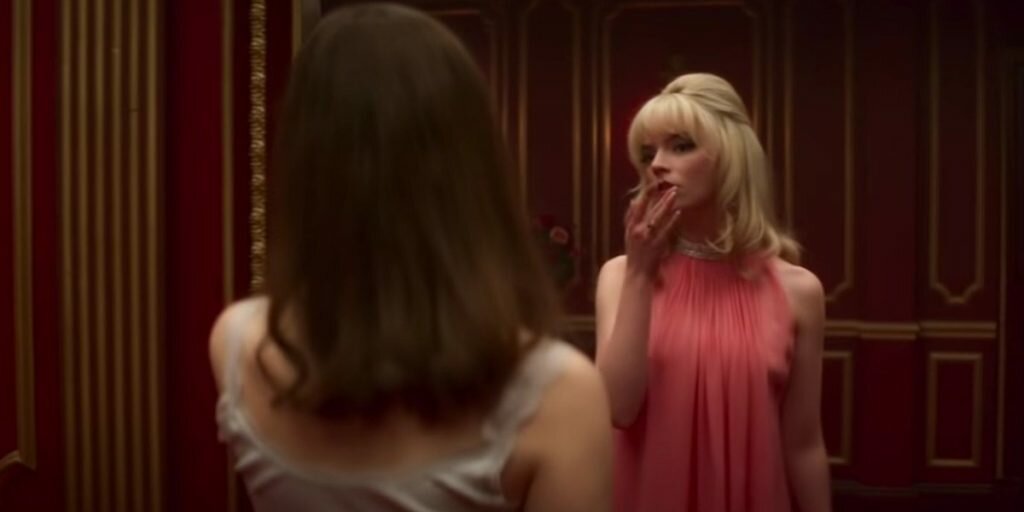Why Eloise in Last Night in Soho is Autistic, and Why That Matters
Last Night in Soho is now in theatres, and Edgar Wright’s latest is already making the rounds when it comes to online discourse. Although the reception definitely skews positive, critical reviews and audience response aren’t quite as unanimous as is typical for a Wright feature. Yet amidst all the discussion about the execution of the film’s themes and its twisty third act, one point has barely been brought up that was absolutely pivotal in how I absorbed the film, and why I connected with it so strongly: namely, the coding of protagonist Eloise as autistic.
Not only did looking at the film through this lens make Last Night in Soho an incredibly personal experience for me, it also illuminates a deeper meaning than many people are giving the film credit for.
Alone In The City

At the beginning of Last Night in Soho, the first image we see is Eloise (Thomasin McKenzie) standing alone in a doorway, with abject darkness filling the rest of the frame. As an isolated image, it’s striking, and has the potential to be a chilling opening for a psychological thriller. Yet that potential is undercut by the choice of music: “A World Without Love” performed by Peter & Gordon, which instead sets a playful mood for the scene, with Eloise lip syncing and dancing around her bedroom. It’s more than a fitting introduction for our main character, but the tension in that first image and what it could have meant lingers over a film which is primarily concerned with a lonely figure passing through both literal and metaphorical doorways, to other times and new experiences, and this theme of transgression is vital to Eloise’s autistic identity.
To be clear, I am not claiming that the filmmakers intentionally portrayed Eloise as autistic. As presented in the film, Eloise is awkward, has difficulty connecting with others, and is relatively insular despite regularly reaching out in various ways. None of these are necessarily indicators of autism, and many similar characters in similar movies share these traits. Nobody ever refers to Eloise as autistic, nor is the word mentioned at any point. However, the specificity of the character’s writing and McKenzie’s performance, intentional or otherwise, mirror aspects of autistic life because of how she displays the symptoms of Asperger’s Syndrome, which for the sake of clarity is currently classified under the umbrella condition of Autism Spectrum Disorder.
It’s in details such as McKenzie’s choice to have Eloise’s line delivery fluctuate between too soft and too loud, often within the same sentence, indicating an issue measuring tone and volume; dramatically retreating from upsetting situations to a realm of comfort, such as her decision to move to an emptier building after only a couple days in a crowded dorm; mimicking the words and cadence of other people to try to paper over social awkwardness (“what’s the most?”); and hyperfixating on a topic of interest, specifically on the 60s and its fashion, to the detriment of her ability to manage her own life. That last point about hyperfixation is the most pertinent, both because it’s the main thrust of the narrative as well as the primary way the autistic coding ties into the film’s exploration of the dark side of nostalgia.
You’re My World

Soon after moving into an upstairs apartment owned by Ms. Collins (Diana Rigg), Eloise starts having vivid dreams that transport her consciousness into the 1960s, where she appears to have a psychic connection with aspiring singer Sandie (Anya Taylor-Joy). Wright uses Eloise’s image in any reflective surface Sandie passes by, and sometimes even has Eloise herself take Sandie’s place in certain shots despite it still being Sandie’s scene. It quickly becomes clear that between shirking a social life to spend more time in the dream world, modelling herself after Sandie in both physicality and clothing, and her fashion assignments being recreations of Sandie’s looks, that Eloise’s sense of identity has increasingly become centered around projecting herself onto someone else whom she is obsessed with.
One of the most common misconceptions about autism is that individuals with the condition lack empathy, the ability to understand and share the feelings of others, when in fact it’s the other way around: autistic people are often overwhelmed with empathy, feeling the joys and pains of others so profoundly that it can affect our own to the point that we emotionally shut down as a coping mechanism. Across the film, Eloise struggles with many new challenges in her life: living in a new city, acclimating to a new social circle, holding a new job. The way she deals with them is to become drowned in nostalgia for an era not her own to the point of it bleeding into her own reality; in essence, she has so much empathy for Sandie that she can no longer live her own life. When Eloise nearly stabs a classmate with scissors because she saw them as one of the ghosts in Sandie’s visions, it’s clear that Sandie’s torments can no longer be effectively distinguished from Eloise’s. An era that was once a comfort for Eloise is now a living nightmare.
This comes to a head after the reveal that Ms. Collins is in fact an older version of Sandie, leading to a confrontation between Eloise and Sandie that takes place in both the real world and the dream one. Despite Ms. Collins trying to kill her, Eloise expresses empathy for her, saying “I know” in response to Ms. Collins saying the abusive men she murdered deserved it, and trying to save her life when she tries to commit suicide. Ms. Collins may wind up consumed by flames in a monument to her past, but before that she urges Eloise to accept a second chance at life, one where she can chart her own course rather than being forever tied to nostalgic wish fulfillment. It’s a message that many can likely relate to, but that autistic people in particular may find resonant. Retreating back to comfort zones and topics of interest may be one of our favourite things, but if we never step through the doorway, we’ll never find out who we could be.
Besides, as shown when Sandie blows a kiss to Eloise in the mirror after her successful fashion show, what comforts you isn’t bad, and it will always be there if you need it. Just don’t let it be all that you are.
If you liked this article, you can check out Carlos’s other work here!
1 Comment
I loved your review. Practically the first thing I thought starting the movie was “ooh Eloise is autistic AF”! and that’s the key to a lot. I love Giallo so I was expecting something very good, but this was awesome.